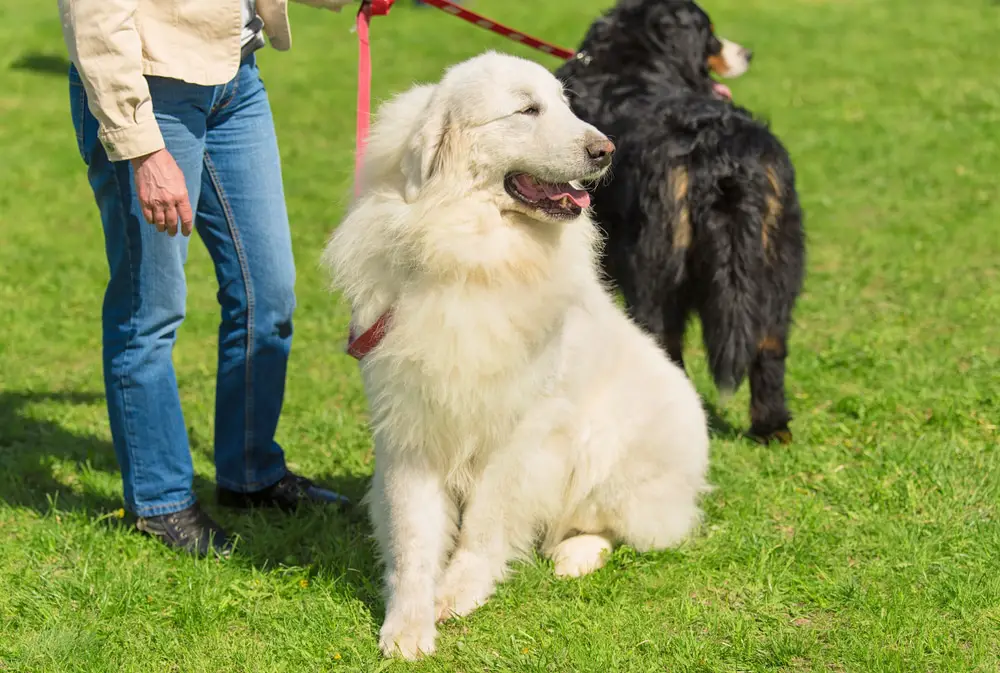The Great Pyrenees breed is often characterized as being lazy, but is this reputation justified?
This article aims to objectively examine the activity levels, behavior, and training needs of Great Pyrenees dogs to determine whether they can truly be labeled as lazy.
Key Takeaways
- The Great Pyrenees breed is often labeled as lazy
- Understanding the nature of the breed and debunking misconceptions is important
- Factors like breed characteristics, health issues, and age can influence laziness in dogs
- Regular exercise and mental stimulation are crucial for the health and behavior of the Great Pyrenees
Understanding the Great Pyrenees Breed
The Great Pyrenees breed is known for its calm and laid-back temperament. While some may consider them lazy dogs, it is important to understand their energy levels and exercise needs. Great Pyrenees dogs are naturally independent and can be quite self-sufficient.
This breed was historically bred to guard livestock, which required them to be alert and patient rather than hyperactive. They have a moderate energy level and are generally content with a moderate amount of exercise.
However, it is important to note that they still require regular physical activity to maintain their overall health and well-being.
Daily walks and mental stimulation are essential to prevent boredom and potential behavioral issues. It is crucial for potential owners to be aware of the exercise requirements of the Great Pyrenees breed before considering them as pets.
Activity Levels and Exercise Needs
Activity levels and exercise needs of the Great Pyrenees breed can be described as moderate, requiring regular physical activity to maintain their health and well-being.
While Great Pyrenees dogs are known for their calm and gentle demeanor, they still possess a considerable amount of energy that needs to be expended. These dogs were originally bred to guard livestock in the mountains, which required them to be active and alert.
Therefore, it is important for owners to ensure that their Great Pyrenees receive daily exercise to prevent them from becoming overweight or developing behavioral issues.
Engaging in activities such as daily walks, playtime, and mental stimulation will help fulfill their exercise needs.
Providing a balanced exercise routine will not only keep the Great Pyrenees physically fit but also mentally stimulated, leading to a happier and healthier dog.
Behavior and Temperament
Behavior and temperament of the Great Pyrenees breed can be characterized as calm and gentle. This makes them a suitable choice for families looking for a peaceful and well-mannered companion.
Great Pyrenees are known for their strong protective instincts and their ability to be gentle with children, making them excellent family pets. They are typically reserved and wary of strangers, which makes them excellent guard dogs.
However, this same characteristic can also make them somewhat aloof and independent. Great Pyrenees are intelligent and independent thinkers, which can sometimes lead to stubbornness. They have a strong sense of loyalty and are known for their devotion to their family.
Overall, the behavior and temperament of the Great Pyrenees breed make them a wonderful choice for those seeking a calm, gentle, and protective companion.
| Behavior | Temperament | Great Pyrenees |
|---|---|---|
| Calm | Gentle | Protective |
| Reserved | Wary | Independent |
| Aloof | Loyal | Intelligent |
Common Misconceptions about Great Pyrenees
One common misconception about the Great Pyrenees breed is that they are not suitable for apartment living due to their large size and exercise needs. However, it is important to note that while Great Pyrenees are indeed large dogs, they are not necessarily lazy.
In fact, they were originally bred to be working dogs, specifically to guard livestock in the mountains.
Although they have a calm and gentle temperament, they are still active and require regular exercise to maintain their physical and mental well-being. While they may not be as hyperactive as some other breeds, they still enjoy activities such as walks, hikes, and playtime.
It is essential to provide them with enough exercise and mental stimulation to prevent boredom and potential behavioral issues.
Therefore, Great Pyrenees should not be dismissed as lazy, but rather understood as dogs that require appropriate exercise and mental engagement.
Training and Mental Stimulation

Training and mental stimulation are essential for maintaining the well-being of Great Pyrenees dogs, as they require regular exercise and mental engagement to prevent boredom and potential behavioral issues.
Great Pyrenees dogs are intelligent and independent thinkers, which can make training a bit challenging at times. However, with consistent and positive reinforcement training methods, they can learn and excel in various activities.
Here are three key aspects to consider when providing training and mental stimulation for Great Pyrenees dogs:
Physical exercise:
These dogs have a moderate energy level and need daily walks, play sessions, or access to a secure yard to run and explore.
Mental challenges:
Great Pyrenees dogs thrive when given tasks that engage their minds. Puzzle toys, obedience training, and interactive games can keep them mentally stimulated.
Socialization:
Exposing Great Pyrenees dogs to different people, animals, and environments from an early age can help develop their social skills and prevent behavioral problems.
By incorporating training and mental stimulation into their routine, Great Pyrenees dogs can lead happy and fulfilling lives.
Keeping in mind, that teaching your dog new things can happen quickly and easily by utilizing some clever online training options.
The training listed below is what we highly recommend for quick results!

Factors that Influence Laziness in Dogs
Factors such as breed characteristics, health issues, and age can contribute to variations in activity levels among dogs.
When considering the Great Pyrenees breed, it is important to note that they are generally known for their calm and laid-back nature. This breed was historically bred to guard livestock, which required them to be vigilant and protective rather than active.
However, laziness in dogs is not solely determined by breed characteristics. Health issues such as obesity, arthritis, or other chronic conditions can also contribute to decreased activity levels.
Additionally, age plays a role, as older dogs tend to be less active than younger ones.
It is crucial to consider these factors when assessing the activity level of a Great Pyrenees or any other dog breed.
Tips for Keeping Your Great Pyrenees Active and Engaged
To ensure the ongoing physical and mental well-being of your Great Pyrenees, it is essential to incorporate engaging activities and stimulation into their daily routine.
Great Pyrenees have a tendency to be lazy if not provided with enough exercise and mental stimulation.
Regular exercise is crucial for maintaining their overall health and preventing obesity, which can lead to various health issues.
Taking them for daily walks, engaging in play sessions, and allowing them to roam in a securely fenced yard can help burn off excess energy. Additionally, providing them with interactive toys and puzzles can keep their minds active and engaged.
It is important to vary their activities to prevent boredom and ensure they remain physically and mentally stimulated. By following these tips, you can help keep your Great Pyrenees active, healthy, and content.
Final Thoughts on whether the Great Pyrenees are Lazy
In summary, the activity levels of Great Pyrenees can be influenced by various factors. This includes their environment and the level of mental and physical stimulation they receive.
While some may consider Great Pyrenees to be lazy, it is important to understand that this breed has a natural tendency to conserve energy. They were historically bred to guard livestock, and their calm demeanor reflects this purpose.
However, it is crucial to provide them with regular exercise and mental stimulation. This helps keep them healthy along with preventing behavioral issues.
Great Pyrenees are known for their endurance, so activities such as long walks, hiking, or even participating in dog sports can help meet their exercise needs.
It is important for owners to understand the needs of this breed and provide them with appropriate outlets for their energy to ensure their overall well-being.
Frequently Asked Questions
How much does a Great Pyrenees typically weigh?
Great Pyrenees typically weigh between 85 to 115 pounds. They are large, powerful dogs known for their sturdy build and majestic appearance. Their weight can vary depending on factors such as genetics, diet, and exercise.
Are Great Pyrenees good with children?
Great Pyrenees are known for being gentle and protective, making them generally good with children. However, as with any breed, individual temperament may vary, and early socialization and proper training are important for a positive interaction between the dog and children.
Do Great Pyrenees shed a lot?
Great Pyrenees are known to shed a moderate amount. They have a thick double coat that requires regular grooming to minimize shedding. This breed’s shedding can increase during seasonal coat changes, requiring additional maintenance.
Are Great Pyrenees easy to train?
Great Pyrenees are not generally considered easy to train. They are intelligent and independent, which can make training a challenge. However, with consistent and patient training methods, they can learn and follow commands effectively.
What are the common health issues that Great Pyrenees face?
Common health issues in Great Pyrenees include hip dysplasia, bloat, patellar luxation, and skin allergies. These conditions can cause discomfort, pain, and may require medical intervention. Regular veterinary check-ups and proper care can help prevent and manage these issues.


